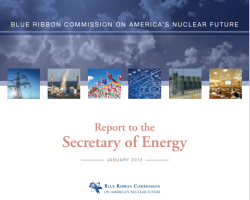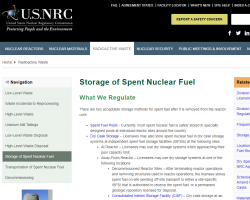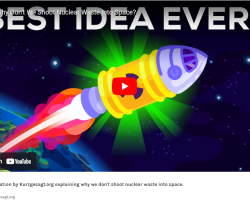Category of Content
Siting Experience Documents Only
Publication Date
Subject Matter
Keywords
Data Qualification Report: Mineralogy Data for Use on the Yucca Mountain Project
Data Qualification Report: Mineralogy Data for Use on the Yucca Mountain Project
Criticality Consequence Analysis Involving Intact PWR SNF in a Degraded 21 PWR Assembly Waste Package
Criticality Consequence Analysis Involving Intact PWR SNF in a Degraded 21 PWR Assembly Waste Package
National Environmental Justice Advisory Council: 20-Year Retrospective Report (1994-2014)
National Environmental Justice Advisory Council: 20-Year Retrospective Report (1994-2014)
This report documents the work of one of the most successful Federal advisory committees in the history of the U.S. Environmental Protection Agency (EPA). The National Environmental Justice Advisory Council (NEJAC) was established by EPA on September 30, 1993 to provide independent advice to the EPA Administrator on broad, cross-cutting issues related to environmental justice.
Intact and Degraded Mode Criticality Calculations for the Codisposal of ATR Spent Nuclear Fuel in a Waste Package
Intact and Degraded Mode Criticality Calculations for the Codisposal of ATR Spent Nuclear Fuel in a Waste Package
Application of Sensitivity/Uncertainty Methods to Burnup Credit Criticality Validation
Application of Sensitivity/Uncertainty Methods to Burnup Credit Criticality Validation
OECD/NEA Burnup Credit Criticality Benchmark, Analysis of Phase II-B Results: Conceptual PWR Spent Fuel Transportation Cask
OECD/NEA Burnup Credit Criticality Benchmark, Analysis of Phase II-B Results: Conceptual PWR Spent Fuel Transportation Cask
Research Supporting Implementation of Burnup Credit in the Criticality Safety Assessment of Transport and Storage Casks
Research Supporting Implementation of Burnup Credit in the Criticality Safety Assessment of Transport and Storage Casks
Radiolytic Specie Generation from Internal Waste Package Criticality
Radiolytic Specie Generation from Internal Waste Package Criticality
Intact and Degrade Mode Criticality Calculations for the Codisposal of TMI-2 Spent Nuclear Fuel in a Waste Package
Intact and Degrade Mode Criticality Calculations for the Codisposal of TMI-2 Spent Nuclear Fuel in a Waste Package
SCALE-4 Analysis of Pressurized Water Reactor Critical Configurations: Volume 3-Surry Unit 1 Cycle 2
SCALE-4 Analysis of Pressurized Water Reactor Critical Configurations: Volume 3-Surry Unit 1 Cycle 2
Science based responses to social myths on nuclear energy
Science based responses to social myths on nuclear energy
In order to promote a sound basis for considering the role of nuclear in climate change, this review spans the technical topics of social and political debate surrounding nuclear energy with a focus on the objective science of these issues including nuclear waste, accidents and overall risk. Novel aspects include the emergence of nuclear energy as being potentially renewable and the antithesis of Fukushima being an argument for the unacceptable risks associated with the use of nuclear energy.
Probabilistic External Criticality Evaluation
Probabilistic External Criticality Evaluation
The Likelihood of Criticality Following Disposal of SF/HLW/HEU/Pu
The Likelihood of Criticality Following Disposal of SF/HLW/HEU/Pu
Supplement to the Disposal Criticality Analysis Methodology
Supplement to the Disposal Criticality Analysis Methodology
Screening Analysis of Criticality Features, Events, and Processes for License Application
Screening Analysis of Criticality Features, Events, and Processes for License Application
Survey of National Programs for Managing High-Level Radioactive Waste and Spent Nuclear Fuel: 2022 Update
Survey of National Programs for Managing High-Level Radioactive Waste and Spent Nuclear Fuel: 2022 Update
In October 2009, the U.S. Nuclear Waste Technical Review Board (Board or NWTRB) published Survey of National Programs for Managing High-Level Radioactive Waste and Spent Nuclear Fuel. For each of the 13 national programs studied, the report catalogued 15 institutional arrangements that had been set in place and 15 technical approaches that had been taken to design repository systems for the long-term management of high-activity radioactive waste.
Comments on the Draft Consent-Based Siting Report and ECA Recommendations
Comments on the Draft Consent-Based Siting Report and ECA Recommendations
Comments on behalf of Energy Communities Alliance submitted to the U.S. Department of Energy on Draft Consent-Based Siting Process for Consolidated Storage and Disposal Facilities for Spent Nuclear Fuel and High-Level Radioactive Waste.
A Community Handbook on Nuclear Energy
A Community Handbook on Nuclear Energy
This handbook was prepared by Energy Communities Alliance (ECA) with funding from the U.S. Department of Energy (DOE), Office of Nuclear Energy, under Cooperative Agreement DE-NE0000006. It does not represent the views of the Department of Energy, and no official endorsement should be inferred. This handbook is an update to the version originally released in March 2012. The authors are Kara Colton, Allison Doman and Seth Kirshenberg of ECA.
Blue Ribbon Commission on America’s Nuclear Future Report to the Secretary of Energy
Blue Ribbon Commission on America’s Nuclear Future Report to the Secretary of Energy
This report highlights the findings and conclusions of the Blue Ribbon Commission on America’s Nuclear Future (BRC) and presents recommendations for consideration by the Administration and Congress, as well as interested state, tribal and local governments, other stakeholders, and the public.
Summary of Consolidated Interim Storage Advantages and Disadvantages from an Integrated Systems Perspective from Prior Reports and Studies
Summary of Consolidated Interim Storage Advantages and Disadvantages from an Integrated Systems Perspective from Prior Reports and Studies
The question of whether centralized storage of civilian spent nuclear fuel (SNF) should be part of the federal waste management system as an intermediate step before permanent disposal has been debated for more than four decades. Centralized storage facilities were included as a potential component of the U.S. spent fuel management system in the Nuclear Waste Policy Act of 1982 (NWPA), but the NWPA did not identify these facilities as being essential.
NRC Online Resources - Storage of Spent Nuclear Fuel Webpage
NRC Online Resources - Storage of Spent Nuclear Fuel Webpage
NRC's "Storage of Spent Nuclear Fuel" includes a short discussion of "What We Regulate"; "How We Regulate"; and links to related information.
Civilian Nuclear Waste Disposal
Civilian Nuclear Waste Disposal
The Congressional Research Service prepared a report in August titled "Civilian Nuclear Waste Disposal." It contains a summary of the radioactive waste management program, and includes an update with recent developments on YM licensing, consent based siting, legislation, volunteer private storage sites, and current policy.
Commercial Spent Nuclear Fuel: Congressional Action Needed to Break Impasse and Develop a Permanent Disposal Solution
Commercial Spent Nuclear Fuel: Congressional Action Needed to Break Impasse and Develop a Permanent Disposal Solution
The Nuclear Waste Policy Act (NWPA), as amended, requires DOE to dispose of spent nuclear fuel and specifies that the only site that may be considered for the permanent disposal of commercial spent nuclear fuel is a geologic repository at Yucca Mountain, Nevada. However, in 2010, DOE terminated its efforts to license a repository at Yucca Mountain, and Congress stopped funding activities related to the site. Since then, policymakers have been at an impasse on how to meet the federal disposal obligation, with significant financial consequences for taxpayers.
3 Reasons Why We Don’t Launch Nuclear Waste into Space
3 Reasons Why We Don’t Launch Nuclear Waste into Space
A viral YouTube video recently discussed the age-old question “why don’t we shoot nuclear waste into space?”
It’s a topic we often get asked about on social media.
While the educational video’s cartoonish depictions of nuclear waste as glowing green ooze made some of our subject matter experts cringe, it’s clear that the content creators did their homework.







